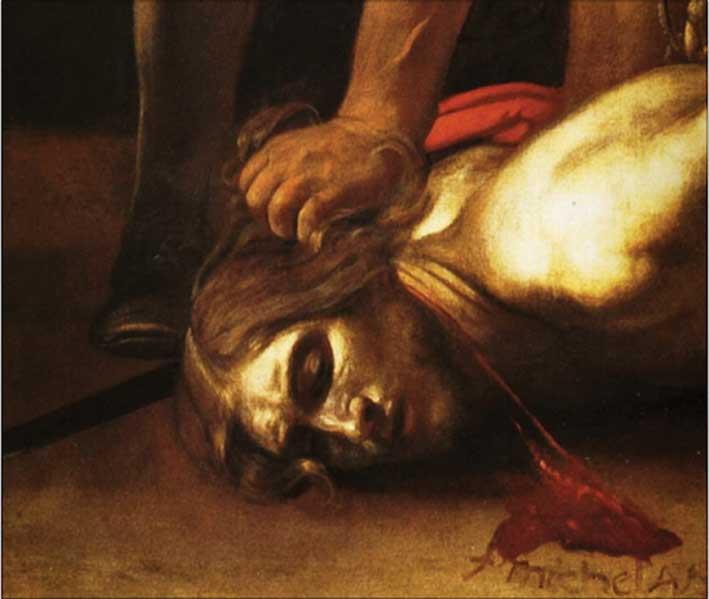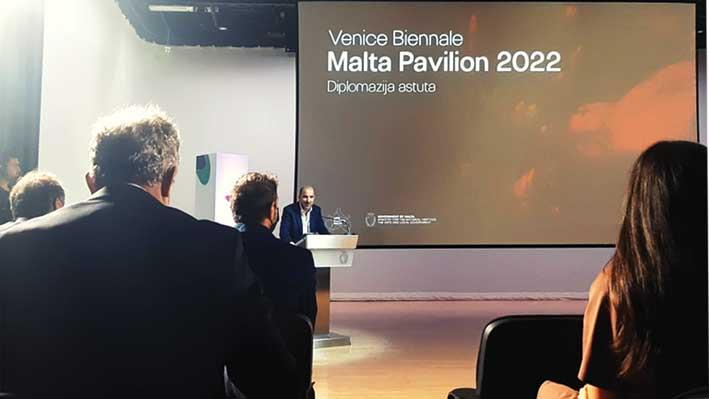Kylie Aquilina
The Maltese Pavilion bridges time by engaging with the central theoretical themes found in the Beheading; justice, reconciliation and peace.
The multiplicity of layers in the site-responsive kinetic installation will allow the visitors to enter into the painting. The artists will be De-Caravaggiseing Caravaggio by bringing him to a minimalist point, stripping his painting from iconography and reintroducing Caravaggio with a renewed interpretation within our century of metal.
St John revolutionised the definition of humanity by the introduction of the phrase "love thy neighbour". The word becomes flesh when the utterance of St John transforms into a utopic or dystopic society. Part of the pavilion installation, Giuseppe Schembri Bonaci's incisions in Metall u Skiet engage with our primordial identity starting with the prehistoric scratches in cave art, the Rosetta Stone and Melqart Pillars, to the metal engulfing today's society. This grounds the installation in our collective Maltese Mediterranean identity.
The multicultural richness of the Mediterranean languages is accompanied by the musical score of Brian Schembri. The composer creates a dialogue with Guido d'Arezzo's seven-note extraction from Ut Queant Laxis, two hymns by Carlo Diacono and the Missa Mundi by Charles Camilleri. The journey through these musical ideologies seeks to organise the movement of the falling steel balls in Arcangelo Sassolino's installation, creating a dramatic choreography.
The title of the theme chosen for the 59th edition of the Venice Biennale is called The Milk of Dreams and is inspired by the surrealist writing of Leonora Carrington. The Venice Biennale curator, Cecilia Alemani, states the importance of the representation of bodies in relation to technology and the Earth. These bodies inhabiting space could transform and metamorphose through time, changing the definition of humanity. Therefore, the theme The Milk of Dreams and the project Diplomazija astuta complement one another.
Matthew Shirfield
As stated by artist Arcangelo Sassolino "Art can only move forward ... art has to step in ground that has never been touched ... but, in order to do so, you have to know exactly what came before". Therefore, in order to understand the themes and concepts being conversed with in this project, one has to first understand the strength and power Caravaggio's masterpiece holds within the Maltese context. In many ways, one can interpret the Master's Early Baroque style as a parallel to the nation's multifaceted artistic identity.

Michelangelo Merisi da Caravaggio, The Beheading of St John (detail), 1608, Oratory of the Decollato, St John's Co-Cathedral (image source: artranked.com)
Naturalism and heavy tenebrism intertwine in The Beheading of St John, thus allowing the viewer to see fragmented forms revealed only by the controlled subdued lighting within the piece. Such is the nature of Caravaggio's work, where tableaux vivants are concealed in darkness, only to be unveiled by a dramatic illumination. This fragmentation of the harmonic forms parallels the eclectic nature of Malta's artistic identity as well as the 20th century developments in art. Through years of colonisation, the Maltese Islands have acquired and lost many artistic styles and reference points which have led to the fragmented eclectic nature of its characterlessness. However, this does not demean the artistic oeuvre of this marginal country but rather elevates it. It conveys the artists' ability to converse with and negate several artistic developments that occur within main cosmopolitan centres. Hence, several artistic languages have been shrouded in darkness due to the shift in power or loss of reference points, yet from the salient artistic contributions of Maltese artists one begins to see the light settling on what Prof Giuseppe Schembri Bonaci termed as the "multicultural richness" and uniquely weaved fabric that makes up the nation's artistic identity.
Hannah Dowling
In 2020, The APS Mdina Cathedral Contemporary Art Biennale, of which Schembri Bonaci is the artistic director, placed a spotlight on the Maltese master of metal sculpture, Toni Pace, in the exhibition Unearthing Metal: A Distance in Time. Pace's sculptures delved beyond the boundaries of art at the time and thus generated controversy among the stone-dominated field of sculpture in the Maltese Islands. Essentially, Pace's metal sculptures embark on a quest for a new language of authenticity in the arts, primarily due to his daring radical departure from the stone, marble and bronze sculpture of Antonio Sciortino and Vincent Apap, for instance. It is for these reasons that these metal sculptures "were a shock for those who believed that there was only one traditional way of doing sculpture", as stated by Clint Calleja. With Toni Pace's use of metal, one could argue that he shifted from insularity by proposing a daringness through his use of materiality; a principle which is echoed in the clay sculptures and drawings of Josef Kalleya and is collectively argued in the Schembri Bonaci's publication Metal and Silence: The quest for daringness and authenticity in the arts (2020).

Professor Keith Sciberras introducing Diplomazija astuta at the Malta Pavilion press launch held on 10 September (photo credit: Kylie Aquilina)
Next year, with Diplomazija astuta, the medium of metal will be at the core of the artistic installation at the Malta Pavilion at the Venice Biennale. Through the technologically kinetic work of Arcangelo Sassolino, the theoretical art of Giuseppe Schembri Bonaci, and the composition of Brian Schembri, the pavilion is to be a dynamic one which underlines metal's importance to the 21st century. While details pertaining towards the pavilion have not yet been released, it is undeniable that the medium of metal is going to be at the artistic core of the project, together with the central element of Caravaggio and his infamous Beheading of St John.
Perhaps, one may note that the two Biennales, the Mdina and Venice Biennale, are united holistically not only through their common use of metal as a medium of translation, but in their daring appropriation of metal in order to unearth an authenticity in the arts. Essentially, Diplomazija astuta's attempt in de-iconising the icon-status of Caravaggio is inexplicably daring in conception. With Sassolino's technological compositions, which echo tension and violence, together with its reverberations in the percussive score by Schembri, and Schembri Bonaci's overall theoretical-artistic approach, one may deduce that the Malta Pavilion at the 2022 Venice Biennale will emanate an aura of authenticity through its daringness. This is achieved precisely by de-iconising and thus unearthing Caravaggio - a status, which essentially matches the daringness of Toni Pace's unearthing use of metal by embracing the constructivist element of faktura within the insular Maltese society of the 1960s.